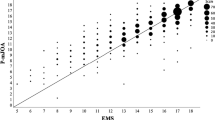Abstract
The ability to compare various results that measure clinical deficits and outcome is a necessity for successful worldwide discussion about cervical spondylogenic myelopathy (CSM) and its treatment. There is hardly any information in literature how to value and compare outcome assessed by different scores. In a retrospective study we objectively evaluated the Nurick-score, Japanese-orthopaedic-association-score (JOA-Score), Cooper-myelopathy-scale (CMS), Prolo-score and European-myelopathy-score (EMS) using the data of 43 patients, all of whom showed clinical and morphological signs of CSM and underwent operative decompression. The scores were assessed pre- and postoperatively. The correlation between the score-results, anamnesis, clinical and diagnostic data was investigated. All the scores show a statistically significant correlation and measure postoperative improvement. With exception of the Prolo-score all scores reflect clinical deficits of CSM. The Prolo-score rates the severity of CSM on the state of the economic situation above clinical symptoms. The main differences of the scores are shown in the number of patients showing postoperative improvement, varying between 33% (Nurick-score) and 81% (JOA-score). The recovery-rates, as a measure of the cumulative improvement of all the symptoms, show less variation (23–37%). The differences of the recovery-rate were only statistically significant between JOA-score, Nurick-score and EMS (P < 0.05), whereas all the other scores showed no significant differences. To assess the postoperative successes, the evaluation of the recovery-rate is essential. There is no significant difference in the recovery-rate amongst the majority of the scores, which allows a good comparison of the results from different studies. Nevertheless, it is always important to differentiate the therapy results of CSM published worldwide.

Similar content being viewed by others
References
Batzdorf U, Batzdorf A (1988) Analysis of cervical spine curvature in patients with cervical spondylosis. Neurosurgery 22:827–836
Bohlmann HH. (1995) Cervical spondylosis and myelopathy. Instr Course Lect 44:81–98
Chagas H, Domingues F, Aversa A et al (2005) Cervical spondylotic myelopathy: 10 years of prospective outcome analysis of anterior decompression and fusion. Surg Neurol 64(Suppl 1):30–35 (discussion: 35–36)
Chiles BWR, Leonard MA, Choudhri HF et al (1999) Cervical spondylotic myelopathy: patterns of neurological deficit and recovery after anterior cervical decompression. Neurosurgery 44(4):762–769 (discussion: 769–770)
Cooper PR, Epstein F (1985) Radical resection of intramedullary spinal cord tumors in adults. Recent experience in 29 patients. J Neurosurg 63:492–499
Davis R (1996) A long-term outcome study of 170 surgically treated patients with compressive cervical radiculopathy. Surg Neurol 46:523–533
Emery SE. (2001) Cervical spondylotic myelopathy: diagnosis and treatment. J Am Acad Orthop Surg 9(6):376–388
Fessler RG, Steck JC, Giovanini MA (1998) Anterior cervical corpectomy for cervical spondylotic myelopathy. Neurosurgery 34(2):257–265
Harada A, Mimatsu K. (1992) Postoperative changes in the spinal cord in cervical spondylotic myelopathy demonstrated by magnetic resonance imaging. Spine 17:1275–1280
Herdmann J, Linzbach M, Krzan M et al (1994) The European myelopathy score. In: Baucher BL, Brock M, Klinger M (eds) Advances in neurosurgery. Springer, Berlin, pp 266–268
Hirabayashi K, Miyakawa J, Satomi K et al (1981) Operative results and postoperative progression of ossification among patients with cervical posterior longitudinal ligament. Spine 6(4):354–364
Houten JK, Cooper PR. (2003) Laminectomy and posterior cervical plating for multilevel cervical spondylotic myelopathy and ossification of the posterior longitudinal ligament: effects on cervical alignment, spinal cord compression, and neurological outcome. Neurosurgery 52(5):1081–1087 (discussion: 1087–1088)
Hukuda S, Xiang LF, Imai S et al (1996) Large vertebral body, in addition to narrow spinal canal, are risk factors for cervical myelopathy. J Spinal Disord 9:177–186
Jörg J. (1992) Rückenmarkerkrankungen. VCH Weinheim, Basel, Cambridge
Keller A, von Ammon K, Klaiber R et al (1993) Die spondylogene zervikale myelopathie: konservative und operative Therapie. Schweiz Med Wochenschau 123:1682–1691
King JTJ, Moossy JJ, Tsevat J et al (2005) Multimodal assessment after surgery for cervical spondylotic myelopathy. J Neurosurg Spine 2(5):526–534
King JT, McGinnis KA, Roberts MS (2003) Quality of life assessment with the medical outcomes study short-form-36 among patients with cervical spondylotic myelopathy. Neurosurgery 52(1):113–121
Law MDJ, Bernhardt M, White AA (1995) 3rd. Evaluation and management of cervical spondylotic myelopathy. Instr Course Lect 44:99–110
Lyu RK, Tang LM, Chen CJ et al (2004) The use of evoked potentials for clinical correlation and surgical outcome in cervical spondylotic myelopathy with intramedullary high signal intensity on MRI. J Neurol Neurosurg Psychiatry 75(2):256–261
Naderi S, Özgen S, Pamir MN et al (1998) Cervical spondylotic myelopathy: surgical results and factors affecting prognosis. Neurosurgery 43(1):43–49 (discussion: 49–50)
Nurick S (1972) The pathogenesis of the spinal cord disorder associated with cervical spondylosis. Brain 95(1):87–100
Nurick S (1972) The natural history and the results of surgical treatment of the spinal cord disorder associated with cervical spondylosis. Brain 95(1):101–108
Orr RD, Zdeblick TA. (1999) Cervical spondylotic myelopathy. Approaches to surgical treatment. Clin Orthop 359:58–66
Pallis C, Jones AM, Spillane JD (1954) Cervical spondylosis. Brain 77:274–289
Payne EE (1959) The cervical spine and spondylosis. Neurochirurgia 1:178–196
Prolo D, Oklund SA, Butcher M (1986) Toward uniformity in evaluating results of lumbar spine operations. A paradigm applied to posterior lumbar interbody fusions. Spine 11(6):601–606
Rajshekhar V, Kumar GS (2005) Functional outcome after central corpectomy in poor-grade patients with cervical spondylotic myelopathy or ossified posterior longitudinal ligament. Neurosurgery 56(6):1279–1284 (discussion: 1284–1285)
Rattcliff J, Voorhies RM. (2001) Outcome study of surgical treatment for axial neck pain. South Med J 94(6):595–602
Restuccia D, Di Lazzaro V, Lo Monaco M et al (1992) Somatosensory evoked potensials in the diagnosis of cervical spondylotic myelopathy: preliminary data. Electromyogr Clin Neurophysiol 32:389–395
Schön H (1999) Stellenwert der somatosensibel evozierten Potentiale in der prä- und postoperativen Beurteilung der zervikalen spondylophytär bedingten Myelopathie. Innaugural dissertation Leipzig 92
Suda K, Abumi K, Ito M et al (2003) Local kyphosis reduces surgical outcomes of expansive open-door laminoplasty for cervical spondylotic myelopathy. Spine 28(12):1258–1262
Yamazaki T, Yanaka K, Uemura K et al (2003) Cervical spondylotic myelopathy: surgical results and factors affecting outcome with special reference to age differences. Neurosurgery 52(1):122–126
Yonenbou K, Fuji T, Ono K et al (1985) Choice of surgical treatment for multisegmental cervical spondylotic myelopathy. Spine 10:710–716
Yue WM, Tan SB, Tan MH et al (2001) The Torg-Pavlov-ratio in cervical spondylotic myelopathy: a comparative study between patients with cervical spondylotic myelopathy and a nonspondylotic, nonmyelopathic population. Spine 26(16):1760–1764
Author information
Authors and Affiliations
Corresponding author
Rights and permissions
About this article
Cite this article
Vitzthum, HE., Dalitz, K. Analysis of five specific scores for cervical spondylogenic myelopathy. Eur Spine J 16, 2096–2103 (2007). https://doi.org/10.1007/s00586-007-0512-x
Received:
Revised:
Accepted:
Published:
Issue Date:
DOI: https://doi.org/10.1007/s00586-007-0512-x




